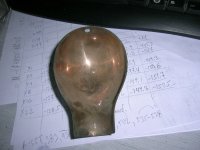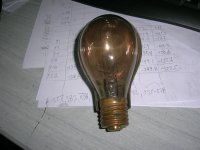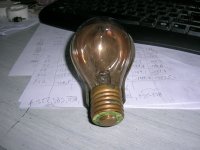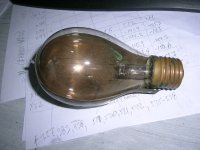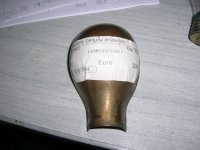I didn't expect this thread to gain so much useful information. And it's not just about the actual light but ballasts as well. Apparently, I have crappy ballasts for my kitchen illumination whereas the lamps last about a year but not much more. Doesn't seem right/good.
That's the point.The big disadvantage of those is they do not have an even spectrum but three (r-g-b) peaks, so the cri is very bad. R-g-b-w strips are probably better, there are also cold+warm white strips that can be tuned. Pure rgb strips may still be useful as additional effect lighting!
Fluos also have lots of peaks but much worse, lots of gaps.
They may "seem" pure white but are not, by any means.
Enhanced red types just add a stronger red peak, still leaving gaps.
The humble 75 W filament lamp in the old school trio solved both: lots of red but more important , continuous spectrum.
People who think 300B are the pinnacle of Audio deserve candles.Maybe I should upgrade from candles!
Or, best case, gas lighting. 🙂
Real hardcore guys should use carbon filament lamps and wax cylinders 😱
I would upgrade, but I just got a box of 100 candles enough for a year. Then there is the problem of I don’t know where to get gas fixtures!
Around here there are quite a few street light gas fixtures. Very bright and considered charming. Interestingly enough more reliable than the electric ones.
Around here there are quite a few street light gas fixtures. Very bright and considered charming. Interestingly enough more reliable than the electric ones.
You could rig a Coleman lantern for the natgas!I would upgrade, but I just got a box of 100 candles enough for a year. Then there is the problem of I don’t know where to get gas fixtures!
Around here there are quite a few street light gas fixtures. Very bright and considered charming. Interestingly enough more reliable than the electric one
I still have the 2 mantel Coleman wifey and I used on our honeymoon camping at Lake George. Used to get white gas at Sears.
I was fortunate enough to get some high bay lights left over from Target store upgrade. They are serious overkill but I can't go back. Downside is that old laptops and CRT's are harder to see in this light. My vintage Panlux meter says is 1000 lux at the work surface.

Lucky guy. My wife would never let me take over the garage. I've tried. Still have to leave room to park her car...
I found local Crompton ballasts using mosfets to perform better than Philips / others using MJ13005 transistors for 36/40 W fluorescent lamps.
There are circuits using MJ13003 for 18W and smaller CFL as well, they work quite well.
You could check your wiring, a weak neutral causes all sorts of issues, and buy good quality lamps and ballasts.
Also, go for the widest voltage band on LED drivers, 85-277 V are the best built, Meanwell is very popular.
No ties to any companies named above...
There are circuits using MJ13003 for 18W and smaller CFL as well, they work quite well.
You could check your wiring, a weak neutral causes all sorts of issues, and buy good quality lamps and ballasts.
Also, go for the widest voltage band on LED drivers, 85-277 V are the best built, Meanwell is very popular.
No ties to any companies named above...
This is California. Until recently no one used garages for cars. They were always junk collection containers. However, now that stealing cars is a teenage sport we are all reconsidering. . .Lucky guy. My wife would never let me take over the garage. I've tried. Still have to leave room to park her car...
Close 🙂People who think 300B are the pinnacle of Audio deserve candles.
Or, best case, gas lighting. 🙂
Real hardcore guys should use carbon filament lamps and wax cylinders 😱
(from the wonderland of old and rare finds (Firenze, Italy))
Attachments
You could rig a Coleman lantern for the natgas!
I still have the 2 mantel Coleman wifey and I used on our honeymoon camping at Lake George. Used to get white gas at Sears.
I still use a gas mantel lamp on the very rare occasion we have a power cut (LPG fuelled).
When I was a kid, we used them all the time as we lived in a place where we ran our own diesel generators (no electricity scheme), so once the gen set was switched off at night we used a gas lamp.
Same experience 🙂
Born in a rural town in the middle of the Pampas, we had electricity in the City of course but lots of farmers and cattle growers around did not, so standard installation was a trusty old Lister single piston generator (with a huge flywheel) driving a 32V DC generator, which was started at dusk and turned off at, say, 10pm
There was a large 32V battery bank but it fed only the main house and not much farther away because of wiring losses so everywhere else it was kerosene/paraffin fed mantle lamps, the kind where kerosene under pressure and temperature turns into gas.
Burns blue by itself, very clean, and mantle gives out very white and powerful light.
So much so that those lamps are known here is as "Sol de Noche": "Night Sun"
A well deserved nickname.
Born in a rural town in the middle of the Pampas, we had electricity in the City of course but lots of farmers and cattle growers around did not, so standard installation was a trusty old Lister single piston generator (with a huge flywheel) driving a 32V DC generator, which was started at dusk and turned off at, say, 10pm
There was a large 32V battery bank but it fed only the main house and not much farther away because of wiring losses so everywhere else it was kerosene/paraffin fed mantle lamps, the kind where kerosene under pressure and temperature turns into gas.
Burns blue by itself, very clean, and mantle gives out very white and powerful light.
So much so that those lamps are known here is as "Sol de Noche": "Night Sun"
A well deserved nickname.
Last edited:
Hey, we also ran a Lister, but it produced 240v. My family ran a country roadhouse and it was needed to power the business premises, including petrol pumps. There was another brand of generator for a backup, but I just can't remember the brand at the moment.
I actually sold my Dad's old Tilley brand kerosene lamp just a few years ago, so I've seen how good the light is from these. I was surprised I could still get parts for them.
More OT (sorry guys), but some people now might be surprised our telephones had no dial; just a winding handle to generate a voltage and ring the bell at the exchange in the local post office, so you could ask the operator to put you through to whatever number. The town was so small, our telephone number was 23.
I actually sold my Dad's old Tilley brand kerosene lamp just a few years ago, so I've seen how good the light is from these. I was surprised I could still get parts for them.
More OT (sorry guys), but some people now might be surprised our telephones had no dial; just a winding handle to generate a voltage and ring the bell at the exchange in the local post office, so you could ask the operator to put you through to whatever number. The town was so small, our telephone number was 23.
Mantles were sold here for those lamps, until a few years back..
My aunt gave me a spirit powered clothes iron, it was made by Tilley (England), a sort of blow lamp to warm the base.
Used by my uncle, a policeman, to iron his uniform when camping in tents.
They even had a kerosene powered fridge......
My aunt gave me a spirit powered clothes iron, it was made by Tilley (England), a sort of blow lamp to warm the base.
Used by my uncle, a policeman, to iron his uniform when camping in tents.
They even had a kerosene powered fridge......
My uncle used to be in charge of a diesel power station in rural Gujarat in the early 60s, before grid power, Deutz and Mirlees Blackstone engines, dynamos. DC.
Supply to a small town, maybe a thousand connections.
Some or the other local would overload, and act innocent...
I have seen many military surplus generators, in some cases the original gasoline engines had been replaced with tractor engines which ran on diesel.
Supply to a small town, maybe a thousand connections.
Some or the other local would overload, and act innocent...
I have seen many military surplus generators, in some cases the original gasoline engines had been replaced with tractor engines which ran on diesel.
So as far as lighting, this company makes very good products. They publish full photometric reports for all of the illumination products, and some of independent reviewers on the web seem to have validated the results. Are the lighting products cheap? No. But, they are one of the only turnkey sources for truly high quality lights that I have been able to find.
https://www.waveformlighting.com/
The other solution, which is a lot cheaper and more fun if you are into DIY, is to make your own solutions with Bridgelux LED products. Their big thing seems to be good coverage of the R9 color band with their proprietary phosphor blend.
An almost-turnkey solution is their BXEB strip modules. You just need a PSU really, although some sort of heat sinking is probably a good idea, and a diffuser would make things more pleasant.
https://www.bridgelux.com/sites/default/files/resource_media/DS171 Bridgelux EB Series Slim Gen3 Data Sheet 20190620 Rev A.PDF
These modules are available at most online electronics dealers for very reasonable prices. A really good product for diffusers is Rohm Satinice acrylic sheets. TAP Plastics in the US sells it, and it is available all over online too I think. It really softens the glare from bare LEDs.
I am working on some custom lighting for my workspace using Bridgelux BXEN Thrive SMD LEDs on some custom boards. Honestly, I would not be surprised if Waveform was using these in their products.
Having super broad spectral output lights makes a world of difference in terms of eye strain and general visual comfort. My garage currently has some Philips Alto TL941 fluorescent tubes, which are about as good as you can get with T8 fluorescents, but I will be replacing them with wither Waveform tubes or some custom designed stuff with the Bridgelux LEDs.
https://www.waveformlighting.com/
The other solution, which is a lot cheaper and more fun if you are into DIY, is to make your own solutions with Bridgelux LED products. Their big thing seems to be good coverage of the R9 color band with their proprietary phosphor blend.
An almost-turnkey solution is their BXEB strip modules. You just need a PSU really, although some sort of heat sinking is probably a good idea, and a diffuser would make things more pleasant.
https://www.bridgelux.com/sites/default/files/resource_media/DS171 Bridgelux EB Series Slim Gen3 Data Sheet 20190620 Rev A.PDF
These modules are available at most online electronics dealers for very reasonable prices. A really good product for diffusers is Rohm Satinice acrylic sheets. TAP Plastics in the US sells it, and it is available all over online too I think. It really softens the glare from bare LEDs.
I am working on some custom lighting for my workspace using Bridgelux BXEN Thrive SMD LEDs on some custom boards. Honestly, I would not be surprised if Waveform was using these in their products.
Having super broad spectral output lights makes a world of difference in terms of eye strain and general visual comfort. My garage currently has some Philips Alto TL941 fluorescent tubes, which are about as good as you can get with T8 fluorescents, but I will be replacing them with wither Waveform tubes or some custom designed stuff with the Bridgelux LEDs.
Avoid Philips LEDs, there are many competitors to Bridgelux, and Cree also has a wide range for different applications.
The only minor issue is that most new packages need machine soldering, the solder pads are at the bottom...
Philips is one of the top 10, but there have been complaints that they cull the production, using the top quality for their own lights, what is sold in the market is off spec.
Their lighting division is now Signify, the chips are made by Lumileds, which was a joint venture with Hewlett Packard, but now owned by Philips alone.
So Philips Lumileds / Lumileds are the names in current use.
Among others, Nichiya, Osram, Citizen are also on the list.
A perusal of photography and printing forums may prove useful..
I am not connected to any names above.
Briefly, use top quality drivers to get best performance, ask around.
The only minor issue is that most new packages need machine soldering, the solder pads are at the bottom...
Philips is one of the top 10, but there have been complaints that they cull the production, using the top quality for their own lights, what is sold in the market is off spec.
Their lighting division is now Signify, the chips are made by Lumileds, which was a joint venture with Hewlett Packard, but now owned by Philips alone.
So Philips Lumileds / Lumileds are the names in current use.
Among others, Nichiya, Osram, Citizen are also on the list.
A perusal of photography and printing forums may prove useful..
I am not connected to any names above.
Briefly, use top quality drivers to get best performance, ask around.
Last edited:
- Home
- Design & Build
- Equipment & Tools
- How do you "illuminate" your workshop?

